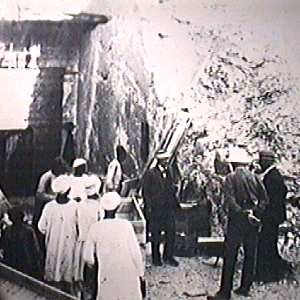
The king was only nineteen when he died, perhaps murdered by his enemies. His tomb, in comparison with his contemporaries, was modest. After his death, his successors made an attempt to expunge his memory by removing his name from all the official records. Even those carved in stone. As it turns out his enemie's efforts only ensured his eventual fame. His name was Tutankhamen: King Tut.
The ancient Egyptians revered their Pharaohs
as Gods. Upon their deaths the King's bodies were carefully preserved by
embalming. The mummified corpses were interned in elaborate tombs (like
the Great Pyramid) and surrounded with all the riches the royals would
need in the next life. The tombs were then carefully sealed. Egypt's best
architects designed the structures to resist thieves. In some cases heavy,
hard-granite plugs were used to block passageways. In others, false doorways
and hidden rooms were designed to fool intruders. Finally, in a few cases,
a curse was placed on the entrance.

Most of these precautions failed. In ancient times grave robbers found their way into the tombs. They unsealed the doors, chiseled their way around the plugs and found the secrets of the hidden rooms. They stripped the dead Kings of their valuables. We will never know if any of the thieves suffered the wrath of a curse.
Archaeologists from Europe became very interested in Egypt in the 19th century. They uncovered the old tombs and explored their deep recesses always hoping to find that one forgotten crypt that had not been plundered in antiquity. They knew that the Pharaohs had been buried with untold treasures that would be of immense artistic, scientific, and monetary value. Always the archaeologists were disappointed.
In 1891 a young Englishman named Howard Carter arrived in Egypt. Over the years he became convinced that there was at least one undiscovered tomb. That of the almost unknown King Tutankhamen. Carter found a backer for his tomb search in the wealthy Lord Carnarvon. For five years Carter dug looking for the missing Pharaoh and found nothing.
Carnarvon summonded Carter to England in1922 to tell him he was was calling off the search. Carter managed to talk the lord into supporting him for one more season of digging. Returning to Egypt the archaeologist brought with him a yellow canary.
"A golden bird!" Carter's foreman, Reis Ahmed, exclaimed. "It will lead us to the tomb!"
Perhaps it did. On November 4th, 1922 Carter's workmen discovered a step cut into the rock. Then they found fifteen more leading to an ancient doorway that appeared to be still sealed. On the doorway was the name Tutankhamen.
When Carter arrived home that night his servant met him at the door. In his hand he clutched a few yellow feathers. His eyes large with fear, he reported that the canary had been killed by a cobra. Carter, a practical man, told the servant to make sure the snake was out of the house. The man grabbed Carter by the sleeve.
"The pharaoh's serpent ate the bird because it led us to the hidden tomb! You must not disturb the tomb!"
Scoffing at such superstitious nonsense, Carter sent the man home.
Carter immediately sent a telegram to Carnarvon and waited anxiously for his arrival. Carnarvon made it to Egypt by November 26th and watched as Carter made a hole in the door. Carter leaned in, holding a candle, to take a look. Behind him Lord Carnarvon asked, "Can you see anything?"
Carter answered, "Yes, wonderful things."
The tomb was intact and contained an amazing collection of treasures including a stone sarcophagus. The sarcophagus contained three gold coffins nested within each other (left). Inside the final one was the mummy of the boy-king, Pharaoh Tutankhamen. The day the tomb was opened was one of joy and celebration for all those involved. Nobody seemed to be concerned about any curse.
A few months later tragedy struck. Lord Carnarvon, 57, was taken ill and rushed to Cairo. He died a few days later. The exact cause of death was not known, but it seemed to be from an infection started by an insect bite. Legend has it that when he died there was a short power failure and all the lights throughout Cairo went out. On his estate back in England his favorite dog howled and dropped dead.
Even more strange, when the mummy of Tutankhamun was unwrapped in 1925, it was found to have a wound on the left cheek in the same exact position as the insect bite on Carnarvon that lead to his death.
By 1929 eleven people connected with the discovery of the Tomb had died early and of unnatural causes. This included two of Carnarvon's relatives, Carter's personal secretary, Richard Bethell, and Bethell's father, Lord Westbury. Westbury killed himself by jumping from a building. He left a note that read, "I really cannot stand any more horrors and hardly see what good I am going to do here, so I am making my exit."
What horrors did Westbury refer to?
The press followed the deaths carefully attributing each new one to the "Mummy's Curse." By 1935 they had credited 21 victims to King Tut. Was there really a curse? Or was it all just the ravings of a sensational press?
Perhaps, the power of a curse is in the mind of the person who believes in it. Howard Carter, the man who actually opened the tomb, never believed in the curse and lived to a reasonably old age of 66 before dying of entirely natural causes.
Outside the tomb
of King Tut:
